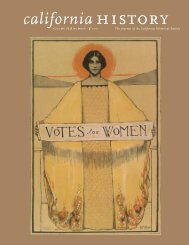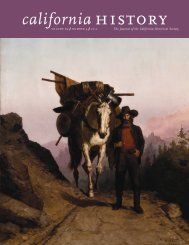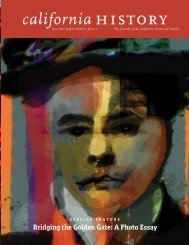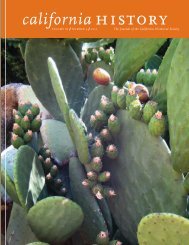Volume 90, Number 1 - California Historical Society
Volume 90, Number 1 - California Historical Society
Volume 90, Number 1 - California Historical Society
Create successful ePaper yourself
Turn your PDF publications into a flip-book with our unique Google optimized e-Paper software.
a man as ever lived.” 58 At least one contemporary<br />
book other than Miller’s own output attests to<br />
the force of the poet’s personality. In his Sunset<br />
review of Adelaide Hanscom’s pictorial interpretation<br />
of the classic The Rubáiyát of Omar<br />
Khayyám, George Wharton James recounts how<br />
Miller, who had agreed to pose for several photogravures,<br />
corralled Sterling, the poet Charles<br />
Keeler, and James himself to stand in for various<br />
characters. As a result of Miller’s intervention,<br />
we have an enduring record of George Sterling<br />
as a thoughtful, retreating soul, Charles Keeler as<br />
an angel shape with a cask of grapes, and James<br />
as a sultan. 59<br />
“bright, partiCular Star”<br />
At the end—February 17, 1913—Miller’s two original<br />
circles reclaimed their own. Five days later,<br />
the First Unitarian Church held a memorial service<br />
with eulogies by the minister, Professor William<br />
Dallam Armes of UC Berkeley, and John P.<br />
Irish. 60 In May, the Bohemian Club orchestrated<br />
a scattering of Miller’s ashes at the Hights. The<br />
Call estimated that five hundred people tromped<br />
up the hill to the site of the poet’s funeral pyre.<br />
Coolbrith “chanted her lines in a full voice that<br />
reached out in the neighboring pines and acacias.”<br />
61 Irish lit the flames, above which the old<br />
gold miner’s ashes were flung. At that point, a<br />
sixty-voice chorus from the club burst forth with<br />
the bard’s own three-verse farewell to himself<br />
titled “Goodby.” The first verse read:<br />
Yon mellow sun melts in the sea,<br />
A somber ship sweeps silently<br />
Past Alcatraz toward Orient skies,<br />
A mist is rising to the eyes,<br />
Good by, Joaquin; good by, Joaquin; good<br />
night, good night. 62<br />
It was more than a goodbye to Miller. It was also<br />
a goodbye to the locale’s literary and social scene:<br />
Stoddard had died four years before; Bierce disappeared<br />
in the Mexican desert one year later;<br />
London died two years after that. The same year<br />
as Miller’s demise, Sterling went on a binge and<br />
his wife initiated a divorce. By 1919, Whitaker<br />
was dead in New York. Despite this disintegration,<br />
the Poet of the Sierras’ influence among<br />
the community lived on. In 1<strong>90</strong>9, a group had<br />
formed the <strong>California</strong> Writers Club with Austin<br />
Lewis as president. Incorporating on February<br />
28, 1913, the association adopted a ship as its<br />
logo and Sail On, from Miller’s poem “Columbus,”<br />
as its motto. In 1919, Oakland’s parks<br />
department acquired most of the Hights, which<br />
became Joaquin Miller Park, where for thirty<br />
years the <strong>California</strong> Writers Club held memorial<br />
activities, culminating in 1941 in the building<br />
of a 1,400-foot-long, Italian-style cascade using<br />
stone brought from the Sierra. Miller would have<br />
been pleased.<br />
The death of the flamboyant author received<br />
national recognition. His reputation had been<br />
building since his, to many Americans, inexplicable<br />
acclaim abroad in the 1870s. By 1893,<br />
the log cabin he had built and lived in for two<br />
years—near the White House—was on exhibit at<br />
the World’s Columbian Exposition in Chicago.<br />
Distinguished in the eyes of his neighbors and<br />
others by his outlandish dress and self-prepared<br />
funeral pyre, Miller was viewed as an eccentric,<br />
but no Bay Area literary event was complete without<br />
him. One local organizer seeking his presence<br />
at an industrial exposition addressed Miller<br />
as Oakland’s “bright, particular star” (the “star”<br />
agreed to lecture; his chosen topic: “The Size of<br />
the Dollar”). 63<br />
By early 1915, various women’s groups were leading<br />
a campaign to preserve the Hights. In 1917,<br />
Abbie, encouraged in her negotiations by John P.<br />
Irish, settled on a price with the city of Oakland<br />
for the Hights while securing lifetime tenure for<br />
herself and a quarter acre for Juanita. Joaquin<br />
Miller Park was duly the largest of Oakland’s<br />
parks for years to come.<br />
59









